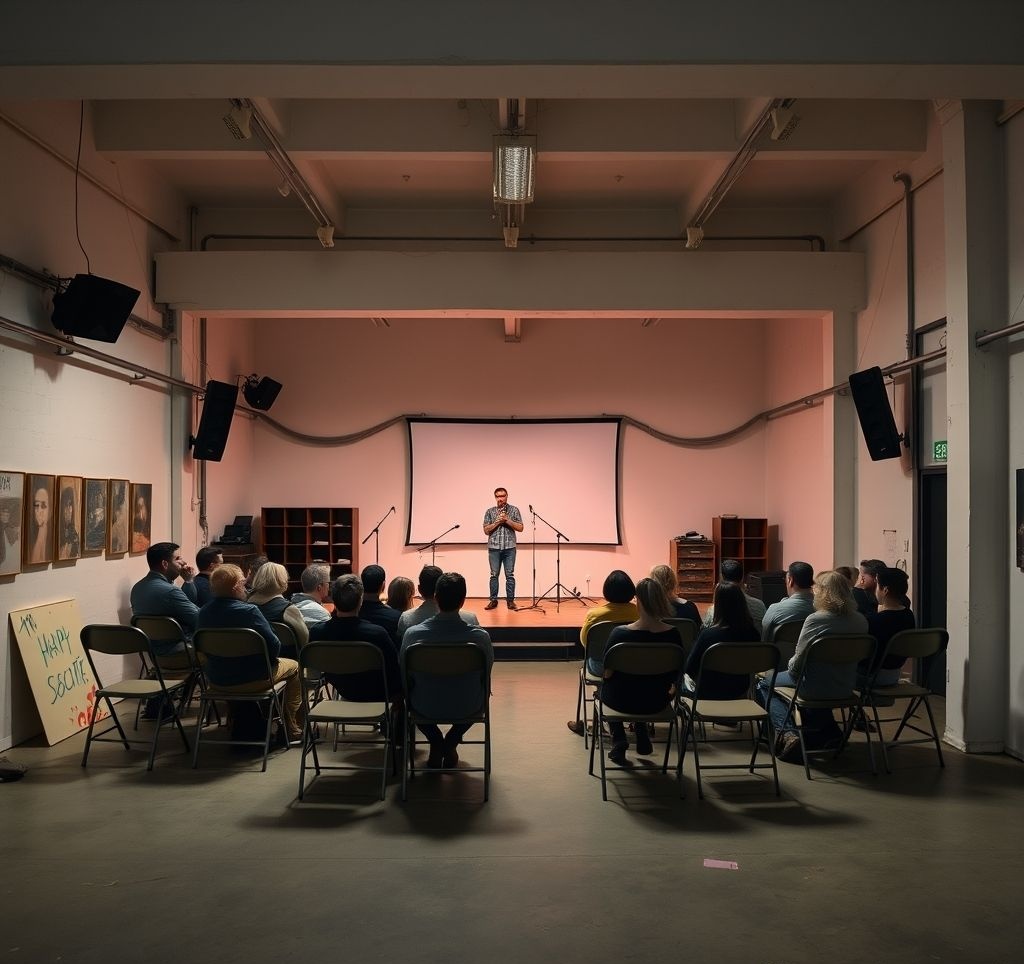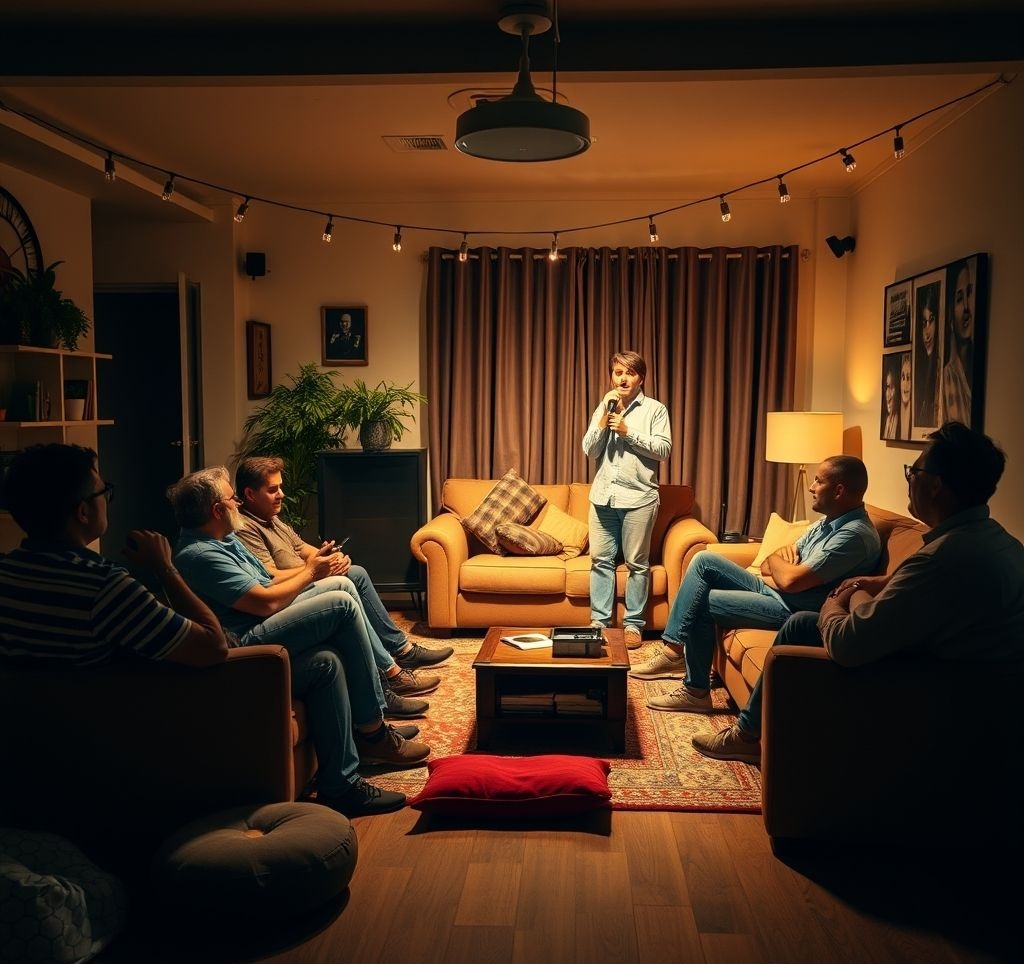The Rise of Micro-Venues & Pop-Up Comedy
How Small, Temporary Spaces Are Revitalizing Alt-Comedy Scenes Worldwide
In the aftermath of the pandemic, comedy has faced a challenging landscape. Many established venues have closed their doors permanently, and those that survived often struggle with high operational costs and increasing rents. But from this disruption has emerged one of the most exciting trends in alternative comedy: the explosion of micro-venues and pop-up comedy spaces.
These small, often temporary performance venues—appearing in bookstores, art galleries, private homes, and repurposed retail spaces—are creating new opportunities for comedians and audiences alike, fostering a DIY ethos reminiscent of punk rock's heyday and democratizing access to comedy production like never before.

The Wandering Mic, a monthly pop-up comedy show, performing in a converted warehouse space.
What Are Micro-Venues?
Micro-venues are small, often unconventional spaces that host live performances for audiences typically ranging from 20-75 people. What sets them apart from traditional comedy clubs is their scale, flexibility, and often their temporary or nomadic nature.
Key characteristics of the micro-venue movement include:
- Capacity: Smaller audiences (usually under 100 people)
- Ephemerality: Many operate as pop-ups that move between locations or appear only for limited runs
- Versatility: Adaptable spaces that might host comedy one night and other arts the next
- Accessibility: Lower overhead means cheaper tickets and easier entry for emerging performers
- Producer diversity: More diverse groups of people can afford to produce shows
- Atmosphere: Intimate settings that create unique performer-audience dynamics
"What's beautiful about these tiny rooms is that you can take real risks. There's an intimacy and energy that's almost impossible to replicate in a 300-seat venue. I've done jokes in living rooms that I'd never attempt at a club, and sometimes those experiments lead to my best material."
— Aparna Nancherla, Comedian
Notable Micro-Venues Across America
Letterpress Bookshop Comedy Night
In the back room of a small independent bookstore, this monthly show combines literary themes with alternative comedy. Performers often create sets responding to a selected book, author, or literary movement, creating a unique intersection of literary and comedy cultures.
The space's limited capacity creates an atmosphere where silence becomes as powerful a tool as laughter, allowing for subtle, nuanced performances rarely possible in larger venues.
The Wandering Mic
This nomadic comedy show never performs in the same place twice. Each biweekly installment takes place in a different location—from art galleries to furniture showrooms, rooftops to recording studios. Location details are sent to ticket holders 48 hours before the show.
The constantly changing venues inspire performers to create site-specific material that responds to each unique environment, making every show a one-time-only experience.
Apartment 4D
Perhaps the most intimate venue on our list, this weekly show literally takes place in the living room of a Brooklyn apartment. Audience members sit on floor pillows, the couch, and folding chairs, while performers stand in front of the fireplace.
Despite—or perhaps because of—its humble setting, Apartment 4D has attracted notable alt-comedy names looking to workshop new material in a low-pressure environment, as well as up-and-coming performers unable to secure spots at more established venues.
Comedy Bodega
Housed in a former convenience store, this venue maintains much of its original aesthetic—performances happen between aisles, with the checkout counter serving as a makeshift tech booth. The unusual layout creates a disruptive environment that challenges traditional stage-audience dynamics.
Comedy Bodega has gained particular recognition for its "Late Night Experiments" series, which specifically showcases material too unusual, risky, or formally challenging for conventional venues.



International Pop-Up Scenes
The micro-venue trend extends far beyond the United States, with particularly vibrant scenes developing in:
- Berlin, Germany: Where "comedy speakeasies" operate in ephemeral locations that change monthly
- Melbourne, Australia: Famous for its "comedy crawl" events that move between multiple small venues in a single night
- Edinburgh, Scotland: Where the Fringe Festival has inspired year-round micro-venues in unconventional spaces
- Mexico City, Mexico: Home to "Comedy En La Azotea," a rooftop comedy series that rotates between residential buildings
- Tokyo, Japan: Where "capsule comedy" shows fit maximum comedy into minimal space, sometimes performing in repurposed train carriages
Why Micro-Venues Matter
The rise of micro-venues represents more than just a practical response to economic challenges. These spaces are fundamentally changing who can produce comedy, who can perform it, and how it's experienced.
Economic Accessibility
With dramatically lower overhead costs than traditional venues, micro-venues enable more diverse groups to produce shows without significant financial risk. This has led to more shows produced by women, people of color, LGBTQ+ individuals, and other groups historically underrepresented in comedy gatekeeping positions.
Creative Freedom
Without the pressure to sell hundreds of tickets or satisfy corporate sponsors, micro-venue producers and performers can take greater creative risks. This has led to formal experimentation that might never happen in conventional clubs focused on reliable laugh-per-minute rates.
Community Building
The intimate nature of these spaces fosters stronger connections between audience members and performers. Many micro-venues have developed loyal communities that return regularly, creating a sense of shared ownership over the comedy experience.
Artistic Cross-Pollination
Because many micro-venues operate in spaces that also host other art forms (galleries, bookstores, music venues), they facilitate natural collaboration between comedy and other creative disciplines—yielding hybrid performances that blur traditional boundaries.
"There's something almost magical about a great show in a tiny space. The laughter feels more honest, the silence more meaningful. These venues are creating a new kind of comedy—one where the audience isn't just consuming jokes but actively participating in a shared experience."
— John Early, Comedian
Challenges and Sustainability
Despite their numerous benefits, micro-venues face distinct challenges:
- Economic sustainability: Lower ticket prices and capacities mean tighter margins
- Zoning and legal issues: Many operate in unofficial or temporarily repurposed spaces
- Accessibility concerns: Unconventional spaces may lack ADA compliance or proper facilities
- Discovery difficulties: Without dedicated locations, potential audiences may struggle to find shows
- Technical limitations: Many lack professional sound, lighting, or recording capabilities
Some micro-venues address these challenges through subscription models, membership programs, or digital content that extends their reach beyond physical limitations. Others partner with local businesses for sponsorship or operate as non-profit entities that can access arts funding.
How to Start Your Own Micro-Venue
Interested in creating a pop-up comedy space in your community? Here's a basic roadmap for getting started:
-
Find Your Space
Look for unconventional venues with low or no rental fees: bookstores after hours, community centers, art galleries between exhibitions, private living rooms, or underutilized commercial spaces. Aim for places that already have chairs and basic amenities.
-
Handle Logistics
Check zoning requirements and any permits needed for public gatherings. Consider insurance options, especially if serving alcohol. Arrange for minimal sound equipment—even a simple microphone and portable speaker can suffice for small spaces.
-
Build Your Lineup
Connect with local comedians interested in alternative spaces or experimental material. Consider themed shows that respond to the specific nature of your venue or mixed-media performances that incorporate elements beyond traditional stand-up.
-
Create an Audience Experience
Think about the full audience journey from arrival to departure. Small touches—like handwritten programs, unique seating arrangements, or post-show discussions—can make your micro-venue feel special and intentional.
-
Promote Thoughtfully
Use focused promotion rather than broad marketing. Email lists, targeted social media, and partnerships with aligned communities often work better than traditional advertising for micro-venues.
The Future of Micro-Venues
As the trend continues to grow, several developments seem likely to shape its future:
- Digital integration: More micro-venues will incorporate livestreaming or recording capabilities, creating hybrid models that extend beyond physical limitations
- Network development: Regional and national networks of micro-venues are emerging, creating touring opportunities for alternative comedians
- Formalization: Some successful pop-ups will likely establish more permanent presences while maintaining their intimate scale
- Media recognition: As these venues continue to incubate innovative comedy, mainstream media attention will increase
- Cooperative models: Member-owned venues where audiences have direct stakes in operations may become more common
What seems certain is that micro-venues have moved beyond being merely a stopgap solution during difficult economic times. They represent a fundamental shift in how alternative comedy can be produced, performed, and experienced—one that prioritizes intimacy, community, and creative risk-taking over scale and standardization.
Resources for Micro-Venue Organizers
- The DIY Comedy Venue Handbook - A free PDF guide to setting up pop-up comedy spaces
- Micro-Venue Network - A national association connecting small venues for resource sharing and tour coordination
- Pop-Up Arts Insurance Collective - Affordable insurance options for temporary performance spaces
- Minimal Tech Guide - Recommendations for affordable, portable sound and lighting equipment
- Alternative Venues Legal Guide - Understanding zoning, licensing, and other legal considerations
As comedian Kate Berlant has noted: "These tiny spaces are where the next evolution of comedy is happening. When you remove the pressure of 'killing' in front of 200 people, you create room for genuine innovation—for shows that might not be consistently funny in a conventional sense, but are consistently interesting, surprising, and alive."
A New Landscape for Alternative Comedy
The proliferation of micro-venues and pop-up comedy spaces is reshaping the alternative comedy landscape in profound ways. By lowering barriers to entry, enabling greater diversity among producers and performers, and creating space for formal experimentation, these intimate venues are fostering a renaissance in live comedy that values community connection and artistic innovation.
In a digital age where comedy is increasingly consumed through screens, these physical micro-venues offer something paradoxically revolutionary: a return to comedy as an immediate, ephemeral, shared experience between performer and audience. Their small scale, rather than being a limitation, is their greatest strength—allowing for a level of connection, risk-taking, and authenticity that larger venues often struggle to achieve.
Whether you're a performer looking for space to experiment, a producer seeking to create your own comedy environment, or simply an audience member tired of conventional comedy club experiences, the micro-venue movement offers exciting new possibilities for how we create and experience alternative comedy in the 2020s and beyond.